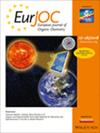Earth-abundant metal complexes as catalysts for the dehydrogenative coupling of hydrosilanes and alcohols
IF 2.5
3区 化学
Q2 CHEMISTRY, ORGANIC
引用次数: 0
Abstract
The dehydrogenative coupling of hydrosilanes with alcohols or water is a fundamental transformation in organosilicon chemistry, enabling the synthesis of alkoxysilanes, silanols, and siloxanes—key materials for coatings and adhesives. Traditionally, these reactions have relied on catalysts based on platinum-group metals (PGMs), which are costly and scarce. The development of Earth-abundant metal (EAM) catalysts offers a sustainable and cost-effective alternative. This concept article highlights recent advancements in homogeneous EAM catalysis for these transformations, focusing on mechanistic insights, reactivity trends, and catalytic efficiencies. Catalysts based on manganese, iron, cobalt, copper, or zinc, are reshaping the field by offering efficient and selective processes for the synthesis of alkoxysilanes, silanols, and siloxanes. Moreover, a key feature of these catalytic systems is their ability to generate dihydrogen as a byproduct, offering potential applications in hydrogen storage and utilization. Despite the good performances of EAM catalysts in the hydrolysis or alcoholysis of silanes, challenges remain, including improving turnover numbers, substrate scope, and catalyst stability. Future developments integrating computational and experimental approaches will be key to optimizing these systems.求助全文
约1分钟内获得全文
求助全文
来源期刊
CiteScore
5.40
自引率
3.60%
发文量
752
审稿时长
1 months
期刊介绍:
The European Journal of Organic Chemistry (2019 ISI Impact Factor 2.889) publishes Full Papers, Communications, and Minireviews from the entire spectrum of synthetic organic, bioorganic and physical-organic chemistry. It is published on behalf of Chemistry Europe, an association of 16 European chemical societies.
The following journals have been merged to form two leading journals, the European Journal of Organic Chemistry and the European Journal of Inorganic Chemistry:
Liebigs Annalen
Bulletin des Sociétés Chimiques Belges
Bulletin de la Société Chimique de France
Gazzetta Chimica Italiana
Recueil des Travaux Chimiques des Pays-Bas
Anales de Química
Chimika Chronika
Revista Portuguesa de Química
ACH—Models in Chemistry
Polish Journal of Chemistry.

 求助内容:
求助内容: 应助结果提醒方式:
应助结果提醒方式:


